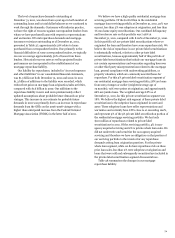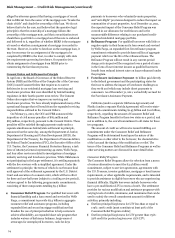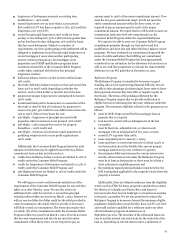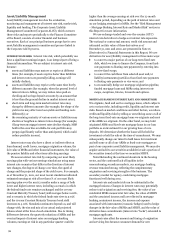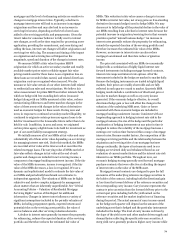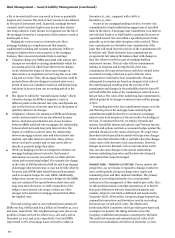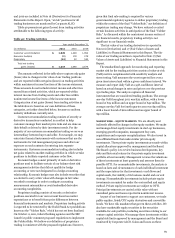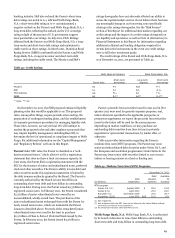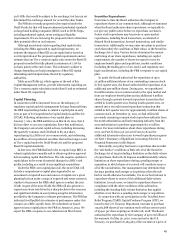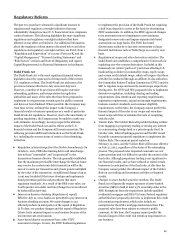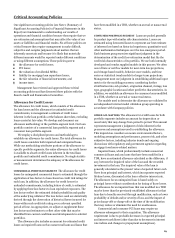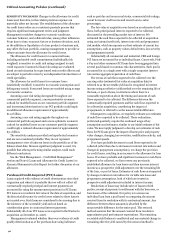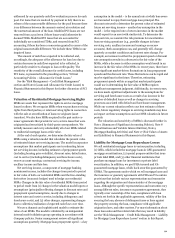Wells Fargo 2011 Annual Report Download - page 83
Download and view the complete annual report
Please find page 83 of the 2011 Wells Fargo annual report below. You can navigate through the pages in the report by either clicking on the pages listed below, or by using the keyword search tool below to find specific information within the annual report.
and 2010 are included in Note 16 (Derivatives) to Financial
Statements in this Report. Open, “at risk” positions for all
trading businesses are monitored by Corporate ALCO.
Table 40 presents net gains (losses) from trading activities
attributable to the following types of activity:
Table 40: Trading Activities
Year ended December 31,
(in millions)
2011
2010
2009
Customer accommodation
$
1,029
1,448
1,854
Economic hedging
(1)
178
278
Proprietary
(14)
22
542
Total net trading
gains (losses)
$
1,014
1,648
2,674
The amounts reflected in the table above capture only gains
(losses) due to changes in fair value of our trading positions
and are reported within net gains (losses) on trading activities
within noninterest income line item of the income statement.
These amounts do not include interest income and other fees
earned from related activities, which are reported within
interest income from trading assets and other fees within
noninterest income line items of the income statement.
Categorization of net gains (losses) from trading activities in
the table above is based on our own definition of those
categories, as further described below, because no uniform
industry definitions currently exist.
Customer accommodation trading consists of security or
derivative transactions conducted in an effort to help
customers manage their market price risks and are done on
their behalf or driven by their investment needs. For the
majority of our customer accommodation trading we serve as
intermediary between buyer and seller. For example, we may
enter into financial instruments with customers that use the
instruments for risk management purposes and offset our
exposure on such contracts by entering into separate
instruments. Customer accommodation trading also includes
net gains related to market-making activities in which we take
positions to facilitate expected customer order flow.
Economic hedges consist primarily of cash or derivative
positions used to facilitate certain of our balance sheet risk
management activities that did not qualify for hedge
accounting or were not designated in a hedge accounting
relationship. Economic hedges may also include securities that
we elected to carry at fair value with changes in fair value
recorded to earnings in order to mitigate accounting
measurement mismatches or avoid embedded derivative
accounting complexities.
Proprietary trading consists of security or derivative
positions executed for our own account based on market
expectations or to benefit from price differences between
financial instruments and markets. Proprietary trading activity
is expected to be restricted by the Dodd-Frank Act prohibitions
known as the “Volcker Rule,” which has not yet been finalized.
On October 11, 2011, federal banking agencies and the SEC
issued for public comment proposed regulations to implement
the Volcker Rule. We believe our definition of proprietary
trading is consistent with the proposed regulations. However,
given that final rule-making is required by various
governmental regulatory agencies to define proprietary trading
within the context of the final “Volcker Rule,” our definition of
proprietary trading may change. We have reduced or exited
certain business activities in anticipation of the final “Volcker
Rule.” As discussed within the noninterest income section of
our financial results, proprietary trading activity is not
significant to our financial results.
The fair value of our trading derivatives is reported in
Notes 16 (Derivatives) and 17 (Fair Values of Assets and
Liabilities) to Financial Statements in this Report. The fair
value of our trading securities is reported in Note 17 (Fair
Values of Assets and Liabilities) to Financial Statements in this
Report.
The standardized approach for monitoring and reporting
market risk for the trading activities consists of value-at-risk
(VaR) metrics complemented with sensitivity analysis and
stress testing. VaR measures the worst expected loss over a
given time interval and within a given confidence interval. We
measure and report daily VaR at a 99% confidence interval
based on actual changes in rates and prices over the previous
250 trading days. The analysis captures all financial
instruments that are considered trading positions. The average
one-day VaR throughout 2011 was $29 million, with a lower
bound of $19 million and an upper bound of $42 million. The
average one-day VaR for fourth quarter 2011 was $32 million,
with a lower bound of $22 million and an upper bound of
$42 million.
MARKET RISK – EQUITY MARKETS
We are directly and
indirectly affected by changes in the equity markets. We make
and manage direct equity investments in start-up businesses,
emerging growth companies, management buy-outs,
acquisitions and corporate recapitalizations. We also invest in
non-affiliated funds that make similar private equity
investments. These private equity investments are made within
capital allocations approved by management and the Board.
The Board’s policy is to review business developments, key
risks and historical returns for the private equity investment
portfolio at least annually. Management reviews the valuations
of these investments at least quarterly and assesses them for
possible OTTI. For nonmarketable investments, the analysis is
based on facts and circumstances of each individual investment
and the expectations for that investment’s cash flows and
capital needs, the viability of its business model and our exit
strategy. Nonmarketable investments include private equity
investments accounted for under the cost method and equity
method. Private equity investments are subject to OTTI.
Principal investments are carried at fair value with net
unrealized gains and losses reported in noninterest income.
As part of our business to support our customers, we trade
public equities, listed/OTC equity derivatives and convertible
bonds. We have risk mandates that govern these activities. We
also have marketable equity securities in the securities
available-for-sale portfolio, including securities relating to our
venture capital activities. We manage these investments within
capital risk limits approved by management and the Board and
monitored by Corporate ALCO. Gains and losses on these
81


